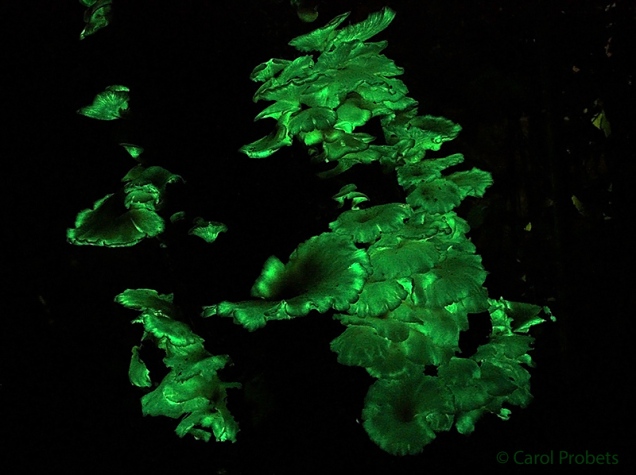
Sometimes the most unexpected things appear literally in our backyard. This happened in February 2016…
I looked out the loungeroom window and did a double take. A huge three-foot-high cluster of white fungi had sprung up on a tree stump in the backyard. Overnight, or so it seemed.
When I went outside and had a close look I noticed the caps were funnel-shaped, the centre of each brown or tinged purple; the gills underneath were forked and extended down the stem. I realised this was most likely Omphalotus nidiformis, the Ghost Fungus, famous for its bioluminescence. In other words, it glows in the dark.
The last time I saw these fungi involved a bushwalk down 1200 stairs into the Jamison Valley at night, lugging tripod and camera to photograph a small cluster in the rainforest. That was March 2013. But this colony just ten steps from my back door was the biggest I’d ever seen!

I could barely wait for night-time.
At last, when twilight dimmed into black, there it was: a ghostly glow in magnificent tiers up the sides of the stump. It took my breath away.

(Click on images to enlarge)
Omphalotus nidiformis grows on dead and living wood in forests throughout southern Australia from south-east Queensland to eastern South Australia, in Tasmania and south-west Western Australia. In case you’re wondering, it is not edible — unless you wish to spend several hours vomiting. Cases of poisoning have reputedly occurred as a result of confusion with edible oyster mushrooms.
It’s one of more than 75 species of bioluminescent fungi worldwide. Why do they glow? Bioluminescence means that light is generated by a chemical reaction inside the living organism. There are several hypotheses for its purpose in fungi. It could be that it attracts nocturnal invertebrates that help disperse the spores, or it might attract predators that eat mycetophagous (fungus-feeding) invertebrates. (While Omphalotus is poisonous to humans, this doesn’t mean it’s poisonous to other species.) Our eyes are poor at distinguishing colour in dim light so we perceive the glow as whitish. The camera, however, records it as green.
The books tell us this species has no smell, but I was aware of a powerful mushroomy odour permeating the air around the cluster. In the still night it was distinctive, evocative, and unforgettable.

While taking photos over the next hour I noticed a multitude of life converging on this part of the garden. There were slugs eating the caps, tiny rove beetles feeding between the gills, moths attracted to the eerie glow and a spider on the prowl, seemingly enticed by the bonanza of bugs. The fungus had become the centre of an entire ecosystem!
The following night I realised how short-lived this ecosystem was. The fungus still glowed, though slightly less brightly but the bustle of life was gone, like a country town on a Sunday afternoon. After a few more days the cluster had shrivelled to shapeless remnants. Soon, there was no evidence at all that a wonderland of interconnected life had briefly existed on this unremarkable stump.




Hey Carol, great to see you’ve taken up blogging, and thanks for this post. I’ve seen a similar glowing fungus on Lord Howe Island but have never tracked down the Queensland variety. Now I have a much better idea of what to look for! Cheers, Paula
LikeLike
Thank you Paula! I’ve enjoyed your artwork and writing for quite a while so am happy you may have learnt something here. I’m still very new to blogging but looking forward to doing lots more. Best of luck chasing down those fungi! Carol
LikeLiked by 1 person
The pictures stunning.
LikeLike
Thank you for dropping by and commenting. Glad you liked the pics!
LikeLike
So cool! That’s awesome that you found such a specimen in your own backyard! Good luck with your blogging journey!
LikeLike
Thank you Gloria! Good luck with your blog too!
LikeLiked by 1 person
Wow that’s such a cool picture of it glowing! And nice info about it too, I enjoyed reading all about it! Looking forward to seeing more of your blog! hope you can check out/follow mine https://myhappycornerblog.wordpress.com 🙂
LikeLike
Thank you Gemma, glad you like it. Your blog looks great and I look forward to exploring it in more detail. Congrats on your graduation!
LikeLiked by 1 person
Thank you!!
LikeLike
Beautiful posts Carol 🙂 loved them all 🙂
LikeLike
Thank you so much!
LikeLiked by 1 person
You’re welcome Carol 🙂
LikeLiked by 1 person
Hallo Carol, I am kang Rahmat from Indonesia. This post very clearly and I like your first posting. anw, in my country many kind of fungi live. And between them, there are we eat.
LikeLike
Thank you Rahmat! I’ve never been to Indonesia but I know you have a great variety of fungi, birds and other living things. I’d love to see them one day! I had a look at your website, your photos are excellent.
LikeLiked by 1 person
thank you for visiting my web. . let’s keep posting 🙂
LikeLiked by 2 people
Terrific blog, Carol, I need to return and read more.
I had a similar interesting encounter a Ghost Fungis here in urban Toowoomba, some pics on my blog: http://ashdown4628.clients.cmdwebsites.com/blog/?p=1584
Cheers, Rob.
LikeLiked by 1 person
Stunning images of glowing fung!
LikeLike
Thanks Pete. Just checked out your blog – wonderful photos! Thanks for all your likes.
LikeLiked by 1 person
You are welcome, Carol. And thank you, too! 🙂
LikeLiked by 1 person